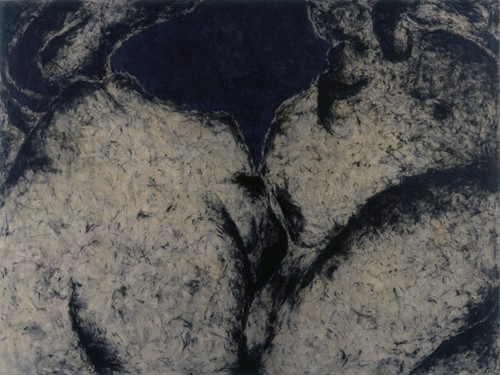From Hara Museum ARC, Gunma
The expression “body and soul” has had a long tradition of use in America, among other countries, appearing in countless titles of songs and movies. In Japan the expression has also become a common one that is mainly encountered in music. The body has been compared to many things; for example, a container for the soul or a shell for the spirit. Some view the body and soul as being one and the same thing, or the body as a medium through which the self interacts with others and the surrounding world. We in this media age experience the body with its expanded capabilities made possible by various tools
and technologies.
In some of the paintings, photographs, sculptures and other works on display, the body is clearly the subject; in others it is not. Nonetheless, it is hoped that their myriad expressions will inspire viewers to consider anew the connection between the body and the spirit and what the body means to them.

Katsuro Yoshida Touch:Body-27 1989
Though Katsuro Yoshida is considered an artist of the Mono-ha group, starting in the latter half of the 1980s, he began his Touch series of paintings which use the tactile sense as a way of validating our connection with the world. He created these drawings using his hand to spread graphite over the picture plane. Instead of starting with a pre-existing idea, he lets the image spring solely from the touch of his hand against the canvas and graphite until the drawing is complete over the entire canvas surface. If we think of painting as a method based on movements centered on the hand (arm) to spread pigment, then we may consider painting to be a kind of expression based on bodily movement, as we do performance or action. One may say Yoshida’s Touch series is an attempt to change the way we perceive the distance between oneself and the world by way of the body.
——————————————————————————————————–
Body and Soul-Selections from the Hara Museum Collection
September 17 (Sat.) – January 4 (Wed.), 2012
Place: Hara Museum ARC Galleries A,B and C
Hours: 9:30 am – 4:30 pm *last entry 30 minutes before closing
Closed: Thursdays during the exhibition period and January 1(open on November 3 and December 29)
*Closed temporarily in the event of severe weather.
Admission: General (over 12) 1,000 yen; children (over 3) 500 yen; 10% discount for a group of 20 or more.
*Children must be accompanied by an adult
**Combination ticket for Hara Museum ARC and Ikaho Green Bokujo ranch: General 1,800 yen; Children 900 yen
Getting There: By train: Take the Joetsu Shinkansen to Takasaki, change to the Joestu Line, and disembark at Shibukawa. From Shibukawa, ARC is 10 minutes away by taxi or 15 minutes by bus (take the Ikaho Onsen bus to “Green Bokujo Mae”). By car: 8 kilometers (about 15 minutes) from the Kan-etsu Expressway Shibukawa Ikaho Interchange (in the direction of Ikaho Onsen).
——————————————————————————————————
ACCESS
By Train
By JR Joetsu・Nagano Shinkansen
Recommended timetable
・10:12 Depart Tokyo Station→11:01 Arrive at Takasaki Station/ 11:11Depart Takasaki Satation→11:35 Arrive at Shibukawa Station
・11:12 Depart Tokyo Station→12:03 Arrive at Takasaki Station/ 12:20 Depart Takasaki Satation→12:44 Arrive at Shibukawa Station
・12:24 Depart Tokyo Station→13:14 Arrive at Takasaki Station/ 13:31 Depart Takasaki Satation→13:56 Arrive at Shibukawa Station
By JR Joetsu Limited Express Kusatsu
・ 9:00 Depart Ueno Station→10:37 Arrive at Shibukawa Station (No.31 ; operates only on Saturdays, Sundays and holidays)
・10:00 Depart Ueno Station→11:43 Arrive at Shibukawa Station (No.3 ; operates only on Saturdays, Sundays and holidays)
・12:00 Depart Ueno Station→13:45 Arrive at Shibukawa Station (No. 5)
From Shibukawa Station, take the Kan-etsu Kotsu Bus and get off at the station “Green Bokujo Mae.” http://www.kan-etsu.net/r-bus/timetable/shibu-ikaho-1.htm (in Japanese only). ARC is about 7 minute walk from the bus station.
By Car
Take the Kan-etsu Expressway to Shibukawa Ikaho Interchange. Go in the direction of Ikaho Onsen for 8 km (about 15 min.) .
Highway information:
E-NEXCO Drive Plaza http://www.driveplaza.com/ (in Japanese only)
<website> http://www.haramuseum.or.jp
<mobile site> http://mobile.haramuseum.or.jp
<Twitter> http://twitter.com/HaraMuseumARC
